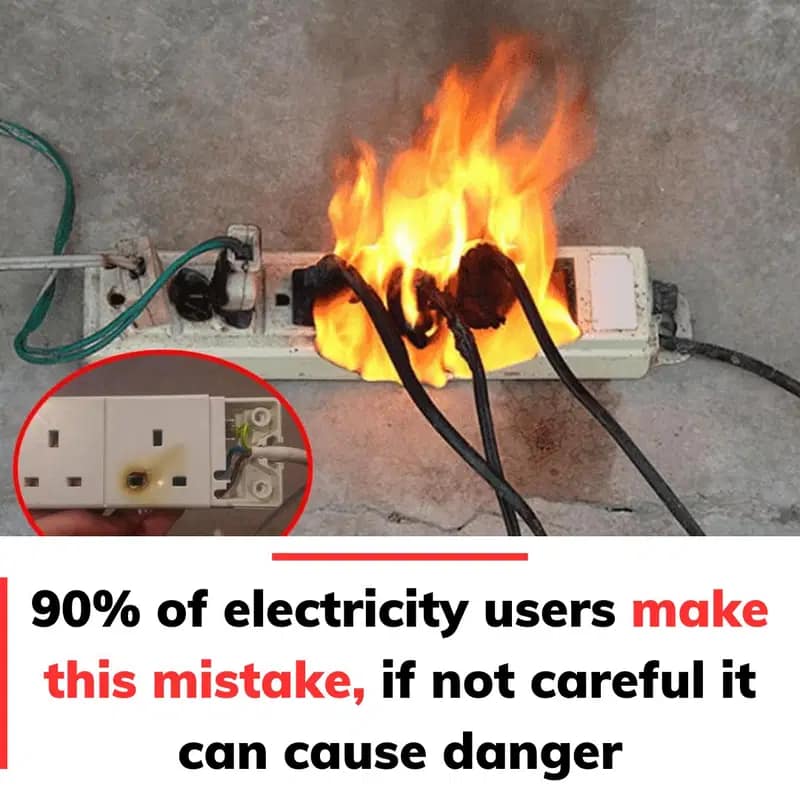In today’s modern world, electricity has become an indispensable part of our lives. It powers our homes, fuels our appliances, and keeps our devices running smoothly. However, despite its importance, most homes are not equipped with enough electrical outlets to accommodate every device and appliance we use daily. To address this issue, extension cords have become an essential tool, allowing us to expand a single socket into multiple outlets. While these cords are incredibly convenient, they are also frequently misused, leading to serious safety risks. Alarmingly, it’s estimated that around 90% of electricity users make common mistakes with extension cords, often without realizing the potential consequences. Let’s explore these mistakes and learn how to avoid them to ensure safety and efficiency in our homes.

1. Plugging One Extension Cord into Another
One of the most common and dangerous mistakes people make is daisy-chaining extension cords—plugging one extension cord into another to increase reach or add more outlets. While it may seem like a quick fix, this practice is extremely unsafe. Extension cords are not designed to handle the electrical load of multiple cords linked together. This setup significantly increases the risk of overheating, melting insulation, and even electrical fires. If you need a longer reach, invest in a single heavy-duty extension cord rated for higher power loads instead of chaining multiple cords together. Safety should always be prioritized over convenience.
2. Using Indoor Extension Cords Outdoors
Extension cords are not one-size-fits-all tools. Indoor extension cords are specifically designed for indoor environments and lack the weatherproofing and durability needed for outdoor use. Exposure to moisture, direct sunlight, and temperature changes can cause damage to the insulation, exposing live wires and increasing the risk of short circuits and fires. If you need an extension cord for outdoor purposes, make sure it is explicitly labeled for outdoor use. These cords are built with weather-resistant insulation and can handle the environmental challenges of being outside.
3. Overloading an Extension Socket
Every extension cord and socket has a specific load limit, which refers to the maximum amount of power it can safely handle. Many people overlook this limit and plug in multiple high-wattage appliances, such as space heaters, microwaves, or coffee makers, into a single extension socket. Overloading the socket causes it to overheat, melt, or even ignite. To avoid this, always calculate the total wattage of all devices you plan to plug into an extension cord. Make sure it does not exceed the cord’s maximum capacity. If you’re frequently using high-power appliances, consider investing in an extension socket with individual switches for each outlet.
4. Covering Extension Cords with Rugs or Furniture
Hiding extension cords under rugs, carpets, or behind furniture may seem like a simple way to keep your home tidy, but it’s also a significant fire hazard. When electricity flows through a cord, it generates heat. Normally, this heat is safely dissipated into the surrounding air. However, if the cord is covered or trapped in a confined space, the heat builds up and can lead to overheating or fire. Additionally, walking over covered cords can damage the insulation and expose live wires, creating a risk of electrical shock. Always keep extension cords in well-ventilated spaces and avoid running them under rugs or furniture.
5. Plugging Beauty Tools into Extension Sockets
Beauty tools like hair dryers, curling irons, and straighteners are high-amperage devices that require significant amounts of electricity to generate heat. Standard extension sockets are often not designed to handle this level of current, and plugging multiple beauty tools into one extension socket can easily overload it. This can lead to tripped circuit breakers, overheating, or even fire. Instead, plug beauty tools directly into a wall outlet, preferably one with a ground fault circuit interrupter (GFCI). GFCI outlets are designed to shut off power in the event of an electrical fault, reducing the risk of electrical shock or fire.
Best Practices for Extension Cord Safety
To use extension cords safely and effectively, follow these essential safety tips:
- Use extension cords rated for your intended purpose (indoor or outdoor).
- Never daisy-chain extension cords together.
- Check the wattage and load capacity of your extension cord.
- Avoid covering cords with rugs or furniture.
- Unplug extension cords when not in use.
- Inspect cords regularly for damage, fraying, or exposed wires.
- Use high-wattage appliances directly in wall outlets.
- Never use extension cords as permanent replacements for wall outlets.
Final Thoughts
Extension cords are incredibly useful tools that make it easier to power multiple devices in homes and offices. However, their convenience comes with responsibility. Misusing extension cords can lead to overheating, appliance damage, and even devastating electrical fires. By avoiding common mistakes such as daisy-chaining cords, using indoor cords outdoors, overloading sockets, covering cords with rugs, or plugging high-wattage beauty tools into extension sockets, you can significantly reduce these risks.
Electrical safety is not something to take lightly, and a few simple precautions can go a long way in ensuring that your home remains safe and accident-free. The next time you use an extension cord, remember these safety tips and make sure you’re using it responsibly. After all, a little attention to detail can prevent a major disaster.





